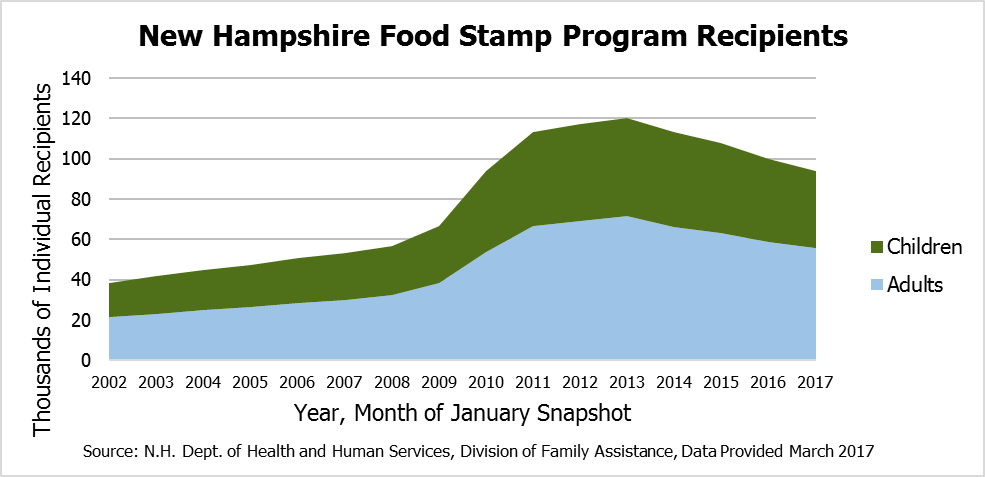New Hampshire’s Food Stamp Program provides financial assistance to low-income people specifically for food purchases. The program is also known by the title of the federal program which provides the funding for all benefits, the Supplemental Nutrition Assistance Program (SNAP). Although the administrative costs of the SNAP program are split with the State, federal funds (totaling about $120 million to New Hampshire in federal fiscal year 2016) pay for the actual costs of the subsidy. The benefits are provided on a sliding scale based on a measure of household income and may only be used to purchase food items intended for human consumption and use.
During January 2017 in New Hampshire, SNAP provided support for food purchases to approximately seven percent of the state’s population. About 40.5 percent of all recipients, or 38,053 individuals, were children. The maximum benefit is $1.83 per person per meal for an eligible household of three with no net income (a measure of income that accounts for certain expenses), and benefits decline as net income increases. As net income for an eligible household of three rises beyond $20,160, benefits disappear. For more on New Hampshire’s Food Stamp Program, see NHFPI’s Fact Sheet.
A new report from the Center on Budget and Policy Priorities (CBPP) highlights the importance of SNAP for people living with disabilities. Those with disabilities, either life-long disabilities or those who have acquired disabilities through accidents or other events, are more likely to have lower incomes, live in poverty, and experience food insecurity. According to one working paper highlighted in the report, a person with severe and chronic disability experiences an average earnings drop of 76 percent in ten years after the onset of the disability relative to five years before its onset, and both family income and food and housing consumption drop about 25 percent. Families with children who have disabilities are especially susceptible to food insecurity, with these families being an estimated 89 percent likelier than families with children who do not have disabilities to cut or skip meals due to a lack of money. People with disabilities may also face higher costs, and not just lower income, associated with their disabilities, including higher costs for health care, personal assistance services or technology, housing, or transportation. SNAP’s income- and asset-dependent eligibility tests mean that SNAP may provide support for people with disabilities after the onset of financial hardships but before the application and vetting processes for programs designed to target assistance to those with disabilities have been completed.
SNAP identifies benefit recipients as those with disabilities if they are under 60 years old and receive certain benefits from other government programs for those with disabilities or have some other indirect indicator of a disability. By this metric, the CBPP analysis found New Hampshire had the highest share of any state of households receiving SNAP benefits and including non-elderly members with disabilities, at 41 percent. The figure for the United States as a whole (including New Hampshire) was 20 percent. Although this metric is narrower than certain others and does not capture many of those who are not receiving benefits from other programs, it shows New Hampshire has a higher percentage than any other state of non-elderly people who have enrolled for SNAP and still fall below the net income threshold ($20,160 for a family of three). This suggests those with recognized disabilities in SNAP still rely on those benefits, perhaps even disproportionately so relative to other states. An important caveat in the program that aids this population: SNAP only applies the net income threshold, not the gross income threshold, to those with disabilities, which permits provision of benefits to continue even with higher housing and other costs.
New Hampshire’s demographics may also spur additional use of SNAP. People with disabilities are more likely to be in poverty regardless of age, and disabilities are more prevalent among older adults. The New Hampshire Office of Energy and Planning projects New Hampshire, with a current total population of about 1.33 million, will have approximately 230,200 more people over aged 65 years and older in 2040 relative to 2010, and approximately 60,300 aged 85 years and older in 2040 than in 2010. These projections suggest that more people with disabilities, as older adults are more likely to have disabilities, may use SNAP to support their daily nutrition.
For more on SNAP and its role in assisting those with disabilities, see CBPP’s June 2017 report, SNAP Provides Needed Food Assistance to Millions of People with Disabilities.

